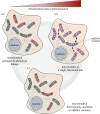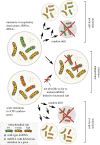Intracellular quality control of mitochondrial DNA: evidence and limitations
- PMID: 31787047
- PMCID: PMC6939369
- DOI: 10.1098/rstb.2019.0176
Intracellular quality control of mitochondrial DNA: evidence and limitations
Abstract
Eukaryotic cells can harbour mitochondria with markedly different transmembrane potentials. Intracellular mitochondrial quality-control mechanisms (e.g. mitophagy) rely on this intracellular variation to distinguish functional and damaged (depolarized) mitochondria. Given that intracellular mitochondrial DNA (mtDNA) genetic variation can induce mitochondrial heterogeneity, mitophagy could remove deleterious mtDNA variants in cells. However, the reliance of mitophagy on the mitochondrial transmembrane potential suggests that mtDNAs with deleterious mutations in ATP synthase can evade the control. This evasion is possible because inhibition of ATP synthase can increase the mitochondrial transmembrane potential. Moreover, the linkage of the mtDNA genotype to individual mitochondrial performance is expected to be weak owing to intracellular mitochondrial intercomplementation. Nonetheless, I reason that intracellular mtDNA quality control is possible and crucial at the zygote stage of the life cycle. Indeed, species with biparental mtDNA inheritance or frequent 'leakage' of paternal mtDNA can be vulnerable to invasion of selfish mtDNAs at the stage of gamete fusion. Here, I critically review recent findings on intracellular mtDNA quality control by mitophagy and discuss other mechanisms by which the nuclear genome can affect the competition of mtDNA variants in the cell. This article is part of the theme issue 'Linking the mitochondrial genotype to phenotype: a complex endeavour'.
Keywords: epistasis; heterogeneity; heteroplasmy; mtDNA; selection; zygote.
Conflict of interest statement
The author declares no competing financial or other interests.
Figures


Similar articles
-
The conflict within: origin, proliferation and persistence of a spontaneously arising selfish mitochondrial genome.Philos Trans R Soc Lond B Biol Sci. 2020 Jan 20;375(1790):20190174. doi: 10.1098/rstb.2019.0174. Epub 2019 Dec 2. Philos Trans R Soc Lond B Biol Sci. 2020. PMID: 31787044 Free PMC article.
-
Reduction of mtDNA heteroplasmy in mitochondrial replacement therapy by inducing forced mitophagy.Nat Biomed Eng. 2022 Apr;6(4):339-350. doi: 10.1038/s41551-022-00881-7. Epub 2022 Apr 18. Nat Biomed Eng. 2022. PMID: 35437313
-
Linking the mitochondrial genotype to phenotype: a complex endeavour.Philos Trans R Soc Lond B Biol Sci. 2020 Jan 20;375(1790):20190169. doi: 10.1098/rstb.2019.0169. Epub 2019 Dec 2. Philos Trans R Soc Lond B Biol Sci. 2020. PMID: 31787041 Free PMC article.
-
Mitochondria: Biogenesis and mitophagy balance in segregation and clonal expansion of mitochondrial DNA mutations.Int J Biochem Cell Biol. 2015 Jun;63:21-4. doi: 10.1016/j.biocel.2015.01.023. Epub 2015 Feb 7. Int J Biochem Cell Biol. 2015. PMID: 25666555 Review.
-
Degradation of paternal mitochondria via mitophagy.Biochim Biophys Acta Gen Subj. 2021 Jun;1865(6):129886. doi: 10.1016/j.bbagen.2021.129886. Epub 2021 Feb 24. Biochim Biophys Acta Gen Subj. 2021. PMID: 33636253 Review.
Cited by
-
Characterization and trans-generation dynamics of mitogene pool in the silver carp (Hypophthalmichthys molitrix).G3 (Bethesda). 2024 Sep 4;14(9):jkae101. doi: 10.1093/g3journal/jkae101. G3 (Bethesda). 2024. PMID: 38922124 Free PMC article.
-
Maternal Low-Protein Diet Leads to Mitochondrial Dysfunction and Impaired Energy Metabolism in the Skeletal Muscle of Male Rats.Int J Mol Sci. 2024 Nov 29;25(23):12860. doi: 10.3390/ijms252312860. Int J Mol Sci. 2024. PMID: 39684571 Free PMC article.
-
Heteroplasmy and Individual Mitogene Pools: Characteristics and Potential Roles in Ecological Studies.Biology (Basel). 2023 Nov 20;12(11):1452. doi: 10.3390/biology12111452. Biology (Basel). 2023. PMID: 37998051 Free PMC article. Review.
-
Control of Mitochondrial Quality: A Promising Target for Diabetic Kidney Disease Treatment.Kidney Int Rep. 2024 Dec 31;10(4):994-1010. doi: 10.1016/j.ekir.2024.12.029. eCollection 2025 Apr. Kidney Int Rep. 2024. PMID: 40303215 Free PMC article. Review.
-
Bioenergetic consequences of sex-specific mitochondrial DNA evolution.Proc Biol Sci. 2021 Aug 25;288(1957):20211585. doi: 10.1098/rspb.2021.1585. Epub 2021 Aug 18. Proc Biol Sci. 2021. PMID: 34403637 Free PMC article.
References
-
- Kukat C, Wurm CA, Spåhr H, Falkenberg M, Larsson N-G, Jakobs S. 2011. Super-resolution microscopy reveals that mammalian mitochondrial nucleoids have a uniform size and frequently contain a single copy of mtDNA. Proc. Natl Acad. Sci. USA 108, 13 534–13 539. (10.1073/pnas.1109263108) - DOI - PMC - PubMed
Publication types
MeSH terms
Substances
LinkOut - more resources
Full Text Sources

